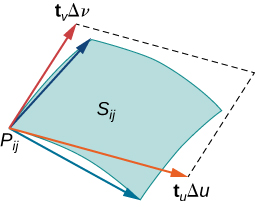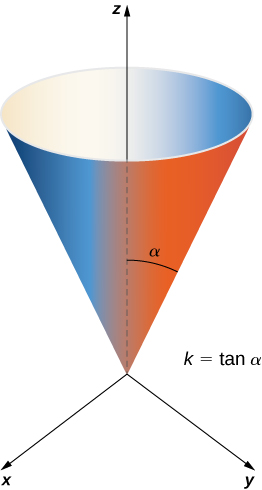| << Chapter < Page | Chapter >> Page > |
Varying point over all pieces and the previous approximation leads to the following definition of surface area of a parametric surface ( [link] ).

Let with parameter domain D be a smooth parameterization of surface S . Furthermore, assume that S is traced out only once as varies over D . The surface area of S is
where and
Calculate the lateral surface area (the area of the “side,” not including the base) of the right circular cone with height h and radius r .
Before calculating the surface area of this cone using [link] , we need a parameterization. We assume this cone is in with its vertex at the origin ( [link] ). To obtain a parameterization, let be the angle that is swept out by starting at the positive z -axis and ending at the cone, and let For a height value v with the radius of the circle formed by intersecting the cone with plane is Therefore, a parameterization of this cone is
The idea behind this parameterization is that for a fixed v value, the circle swept out by letting u vary is the circle at height v and radius kv . As v increases, the parameterization sweeps out a “stack” of circles, resulting in the desired cone.

With a parameterization in hand, we can calculate the surface area of the cone using [link] . The tangent vectors are and Therefore,
The magnitude of this vector is
By [link] , the surface area of the cone is
Since
Therefore, the lateral surface area of the cone is
Show that the surface area of the sphere is
The sphere has parameterization
The tangent vectors are
Therefore,
Now,
Notice that on the parameter domain because and this justifies equation The surface area of the sphere is
We have derived the familiar formula for the surface area of a sphere using surface integrals.
Show that the surface area of cylinder is Notice that this cylinder does not include the top and bottom circles.
With the standard parameterization of a cylinder, [link] shows that the surface area is

Notification Switch
Would you like to follow the 'Calculus volume 3' conversation and receive update notifications?